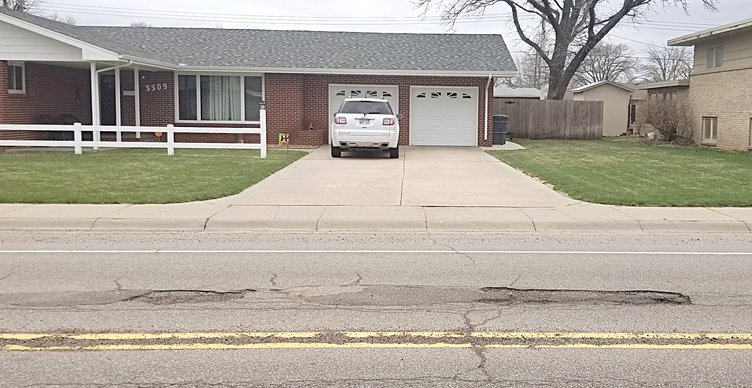Mike Hill said his days are filled with hearing the clunk, clunk of vehicles bouncing through the potholes near his home at 5508 Broadway Ave.
The West Broadway resident has attended two Great Bend City Council meetings this year to complain about the stretch of his street that runs from Patton Road to K-96. He feels he’s been ignored.
“It is horrible out there,” Hill said. These blocks were last resurfaced a few years ago and are now riddled with craters.
But, like any city infrastructure issue, nothing is simple, nor cheap.
“We have crews out now patching holes,” Public Works Director Jason Cauley said, adding they will continue to do so. However, the rain and cold have hindered these efforts some.
In addition, he said they have several other projects in the works that divert their attention.
And, “there are a lot of streets that need to be fixed,” Cauley said. “We’re playing catchup.”
It costs, on average, $30,000 per city block just for a mill and overlay, Cauley said. That fluctuates depending on such factors as oil prices, and excludes the cost of the contractor’s mobilization, traffic control and patching.
So, a lot of time and money are invested, Cauley said.
If they had unlimited funds, they’d love to repair all the streets. “But, we have to pick and choose,” he said.
Great Bend is in the process of developing a five-year plan that will prioritize these projects, Cauley said.
About Broadway
An experiment aimed at saving money has contributed to the problems on Broadway. Three or four years ago, the city did a trial run of a half-inch overlay on several streets. The norm is 2 or more inches.
“At the time, the previous administration was trying to find a solution to lower costs,” Cauley said of West Broadway. In all, eight streets were overlaid this way, but Broadway is the only one having issues, he said.
“This end of Broadway will be addressed in the future,” he said. “But at this time, other projects are taking precedent.”
In the meantime, “you’ll tear your car up” driving down the street, Hill said. Worse yet, this is an emergency route.
“They just blew me off,” he said of the city council. “The city is doing nothing.”
Sure, he said Public Works Street Division crews come out and patch the holes. But, in a matter of days, the patch has been knocked out and the hole remains.
“We need to hold the city accountable,” he said. He believes the city should also hold the contractors’ feet to the fire as well.
He was speaking to Broadway, but noted the same issues exist on other recently redone streets as well.
“I’m frustrated,” he said. “We can spend $1.5 million on rugs for the ball fields (referring to the Sports Complex artificial turf), but we can’t fix our streets?”
Hill is not alone in his frustration. Other area residents have complained and gone to social media with photos of the potholes.
Exacting standards
There are exacting bid specifications for street resurfacing projects, Cauley said. These are developed by Kansas Department of Transportation engineers for work on state and federal roadways or by the city’s on-call engineering firm, Professional Engineering Consultants of Wichita, for city-governed streets.
Among other things, these specs set the scope of the prep work to be done to the road base and asphalt overlay thickness. The city’s assistant engineer inspects the projects as they progress to assure standards are met, Cauley said.
Also, when the project is completed, the city must sign off on it as well. There have been many instances when the contractor has had to correct deficiencies found by city personnel, he said.
Most projects also come with a one- to two-year warranty, he said.
The life expectancy of a mill and overlay project is typically between 10 to 12 years, Cauley said. “But, there are a lot of variables.”
The lifespan can be impacted by the weather at the time of the work and the weather over the course of the years. And, the amount and type of traffic can make a difference.
Hill submitted a Public Forum letter on this topic. It appears on page four, the opinion page, of today’s Great Bend Tribune.




